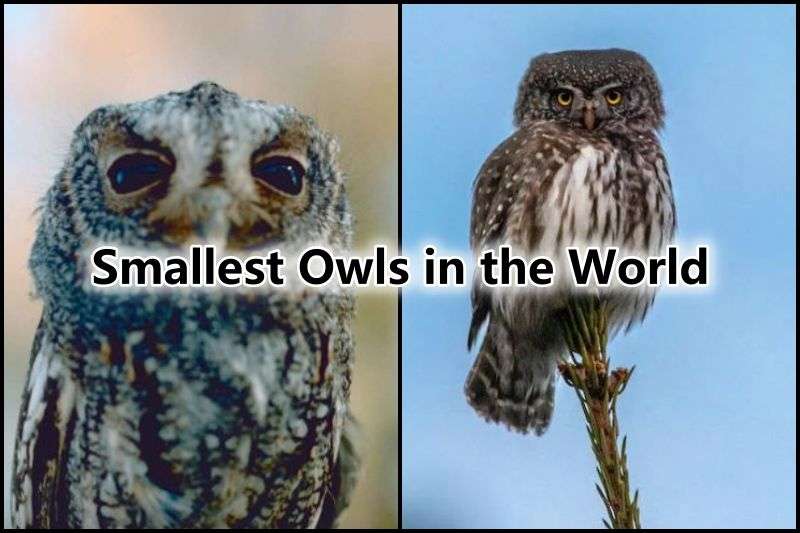Owls are some of the most mysterious and intriguing beings known to mankind. They are intelligent, sociable creatures found worldwide as nocturnal raptors. We have heard many superstitions about them as they have a rich significance in many cultures. Some say that owls are a symbol of death, while others say they are the symbol of wisdom, but there is no doubt that they are unique and interesting creatures.
Owls can be huge and hefty, going up to 6 feet, but at the same time can be extremely small, tiny, and just adorable. In this article, we talk about the Top 13 smallest owls found in the world. Without further ado, let us jump into this topic.
Top 13 Smallest Owls in the World
13) Little Owl
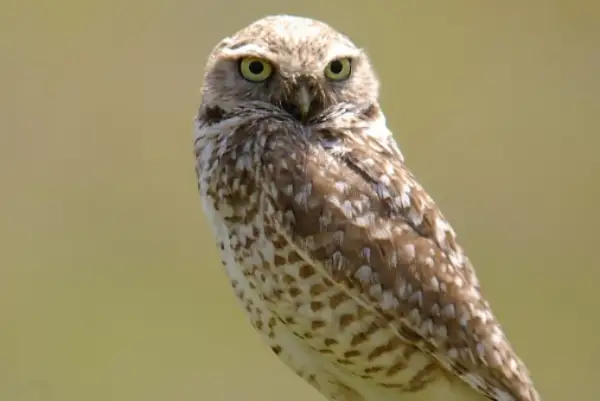
Meet this little owl that’s all about the open spaces – you’ll find it in farmland with hedges, scattered trees, orchards, open woodland, and even quarries. What makes it stand out?
Well, it’s got these distinctive white-spotted upperparts that really catch the eye. Plus, those yellow eyes staring right at you, paired with white brows and a frequently upright stance, give it this super alert appearance.
When it comes to making a home, this owl is into cavities in trees and rocks – a real nature dweller. It’s not shy about being out and about during the day, quietly perching on posts or rocks. But its prime time is from dusk to dawn – that’s when it’s most active.
- Scientific name: Athene noctua
- Size: 8.3 to 9.1 inches tall
- Location: across Europe, Asia, and North Africa
- Diet: insects, earthworms, other invertebrates and small vertebrates
12) Burrowing Owl
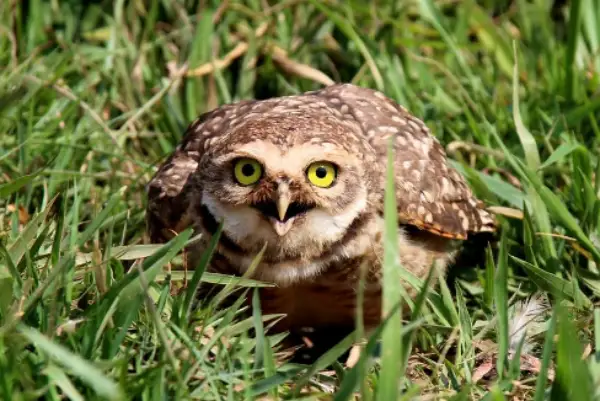
These Burrowing Owls, they’re like these small, sandy-colored birds rocking bright-yellow eyes. Guess what? They’re not living the high life in trees – nope, they’ve got their own digs underground.
They either dig their burrows or move into ones left behind by prairie dogs, ground squirrels, or tortoises. You’ll find them chilling in grasslands, deserts, and open spaces, playing it cool.
- Scientific name: Athene cunicularia
- Size: 7.5 to 10 inches tall
- Location: southern tip of South America into Canada
- Diet: insects, snakes, frogs, small lizards, birds, and rodents
11) Spotted Owlet
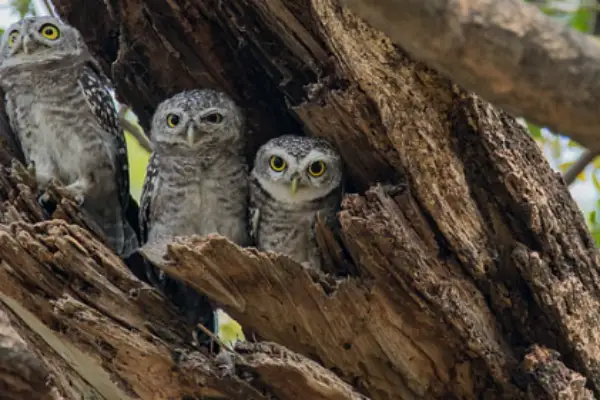
Spotted owlets are widespread throughout the Indian subcontinent. You might catch sight of one peering out from a tree hole or an entire family snugly gathered on a tree branch!
The male and female of this species share a similar appearance, characterized by greyish-brown upperparts adorned with white spots all over. In contrast to many other owls, the Spotted owlet boasts a relatively diminutive body structure, with an adult measuring just around 21 centimeters in size!
- Scientific name: Athene brama
- Size: 7.4 to 8.3 inches tall
- Location: tropical Asia from mainland India to Southeast Asia
- Diet: a variety of insects and small vertebrates
10) FLAMMULATED OWL
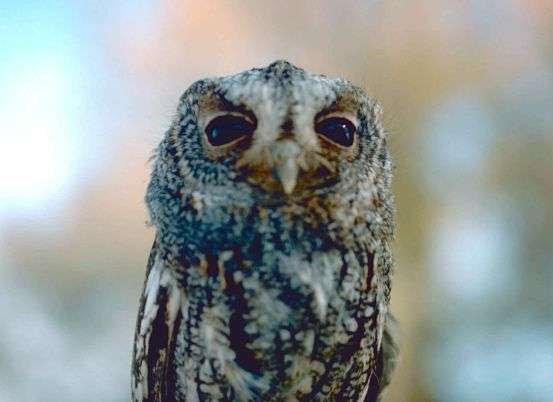
The flammulated owl is a small migratory bird. Being a nocturnal owl, it hunts actively at night. These birds live in cavities made in pine or fir trees and have large windpipes, which allow them to make soft, low-pitched hoots, similar to some of the larger owls.
The owl gets the name ‘flammulated’ from the flame-like patterns on its face. It migrates to Mexico and Central America during the winter.
The color of their plumage ranges from Grey-brown to Rust and White, which makes them well camouflaged against the pine trees. The males are fairly smaller compared to their female counterparts. They have dark eyes and small ear tufts.
- Scientific name: Psiloscops flammeolus
- Size: 6.75 inches
- Location: Canada and United States in the Fall, Central America and Mexico in the Winter
- Diet: Insects
9) YUNGAS PYGMY OWL

The Yungas pygmy owl was recognized as a distinct species quite recently in the 1990s. They are small birds that are about 16cm long and are mostly nocturnal. Its song involves a series of slow-paced hollow notes.
They are widespread in South America, specifically the slopes of the Andes of Peru, Bolivia, and Argentina, and are usually found in the elevated levels or middle levels of the canopy.
These owls can have plumes in three colors. Grey plumes are rare, while Brown plumes and Rufous plumes are common. They have pale white spots throughout the body and pale white bands on their tails.
The adults have a spotted crown, while the juveniles have an unmarked one. They have golden yellow eyes and dirty yellow toes. Unlike other owl breeds, Pygmy owls do not have ear tufts.
- Scientific name: Glaucidium bolivianum
- Size: 16cm (6.3 inches)
- Location: East slope of Andes of Peru, South towards Bolivia, and North-Western Argentina
- Diet: Insects, arthropods, small birds
8) EAST BRAZILIAN PYGMY OWL
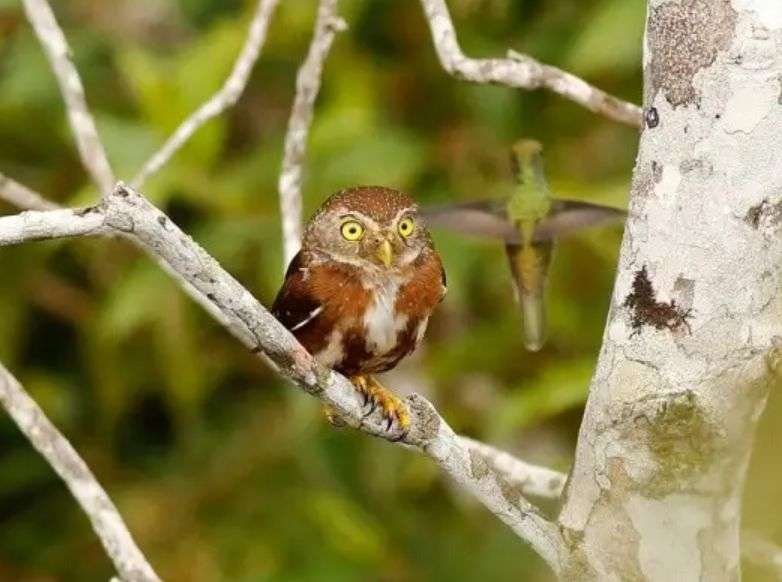
The East Brazilian Pygmy owl is also referred to as the Least Pygmy owl. It is a tiny owl that is about 15 cm long. These owls are mostly diurnal and are the most active during dusk and dawn. Their song is a series of 2-3 high-pitched whistles and is mostly found in Evergreen forests.
These species have a white belly and a rufous back with a White streak. They have a rich Brown crown dotted with tiny white speckles. The plumes of this species of owl areRufous. Their eyes are yellow, and their toes have bristled.
- Scientific name: Glaucidium minutissimum
- Size: 15cm (6 inches)
- Location: East Brazil, Rio de Janeiro, South Catarina
- Diet: Insects, small vertebrates
7) FERRUGINOUS PYGMY OWL

It is the most commonly found species of the pygmy owl, widespread across regions of Central and South America. It is a small and plump bird and yet has oversized claws and talons, which allow them to catch prey larger than its own size. Ferruginous Pygmy Owls are active throughout the day: they are partly diurnal.
A unique characteristic of this owl is that it has an exceptionally long tail, which starts swinging in all directions when agitated.
The song of the owl is a long series of equally spaced notes that goes ‘hoo hoo hoo hoo hoo. ‘ This can be easily imitated, and therefore bird watchers often use this call to attract other birds.
The color of this bird is highly variable, and itranges from a grey-brown plumage to a rufous plumage and many intermediate colors in between. The bird’s crown has white streaks, while the wings have white spots.
They have a pair of White-outlined, dark patches at the back of their head called ‘false eyes,’ which help them to redirect their predators as well as fool their prey.
- Scientific name: Glaucidium brasilianum
- Size: 15cm (6 inches)
- Location: Central and South America
- Diet: Insects, small vertebrates, small birds
6) AMAZONIAN PYGMY OWL
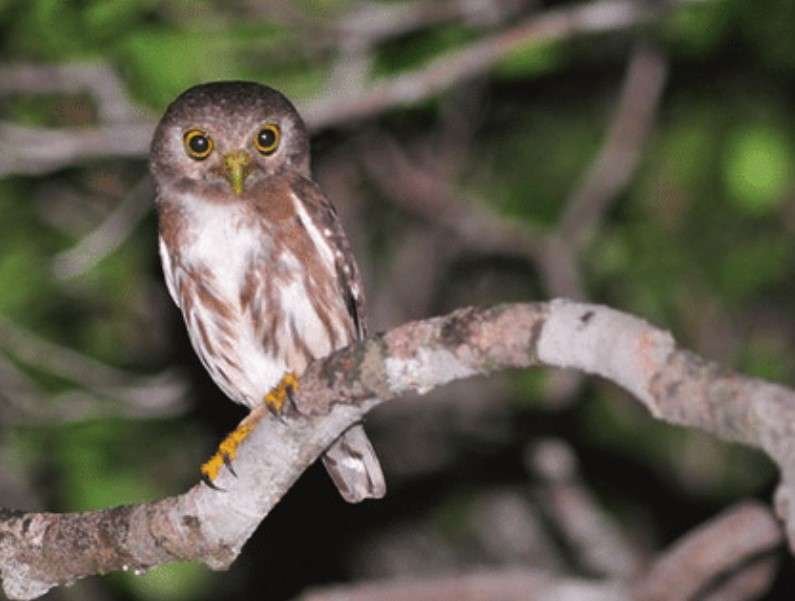
The Amazonian Pygmy Owl, also called Hardy’s Pygmy Owl, is mostly found in the northern regions of South America and the Amazon basin. The habitat for these owls is the canopies of tall, evergreen trees.
Songs of these species are arapid succession of whistled notes, almost like a trill. These owls are diurnal in nature.
The Amazonian pygmy owls have Rufous and Brown plumages and a crown Grey-Brown in color dotted with fine white speckles. They have Golden Yellow eyes and a Greenish Yellow bill. They also have a pair of dark spots at the back of their head as false eyes.
- Scientific name: Glaucidium hardyi
- Size: 5.7 inches
- Location: Central and South America, Amazon basin
- Diet: Arthropods, small vertebrates
5) SUBTROPICAL PYGMY OWL
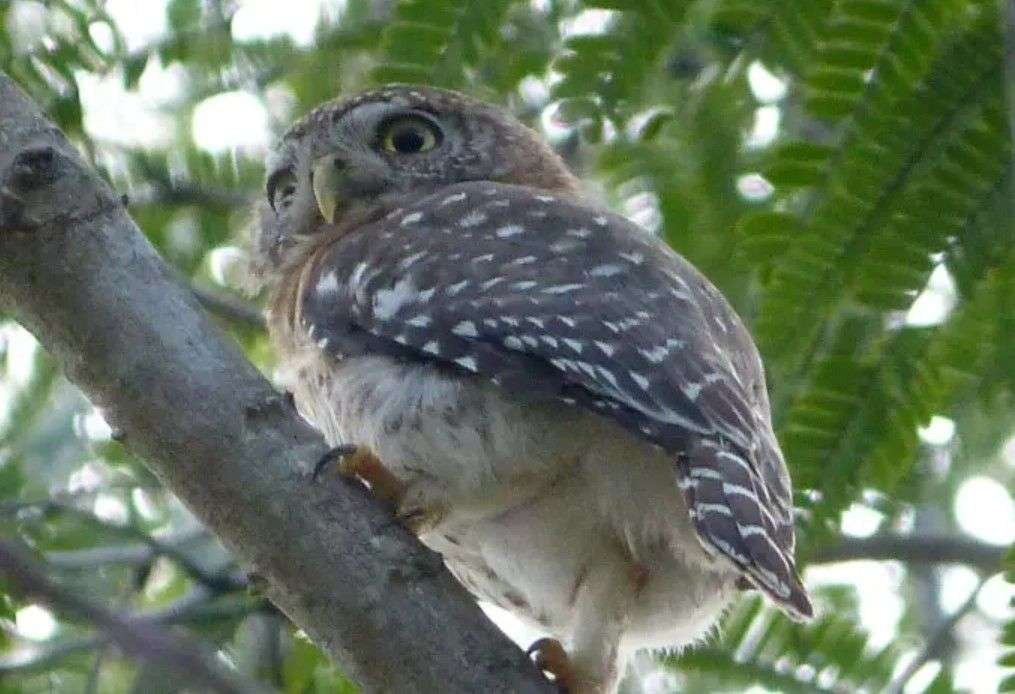
The Subtropical pygmy owl is a poorly known owl species mostly found in the Andes. It is active both day and night.
The owl’s song is3-4 short phrases in a low pitch and increases the pitch when ending the two notes ‘hu-hu’ and having a hesitation before the last note.
Brown plumages can be common, while Rufous plumages are uncommon. The tails of this bird are Blackish in color and are banded in white. These owls have a pair of false eyes, and the back of the bird is dark brown in color.
- Scientific name: Glaucidium parkeri
- Size: 5.5 inches
- Location: East slope of Andes
- Diet: Large arthropods, small vertebrates
4) LONG-WHISKERED OWLETS
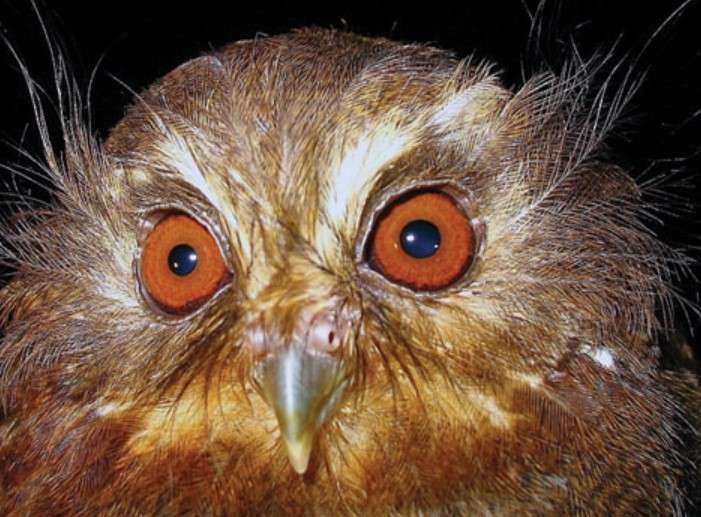
This is a bizarre owl species, which is unique and known for its extremely long facial whiskers. It lives in a Cloud forest habitat. It is 5 inches long and therefore is one of the smallest owls in the world.
Very little is known about these species as it is mostly found in impenetrable dense cloud forest habitats.
This species of owl is mainly brown in color, with a Whitish belly and conspicuous light eyebrows. They are extremely short and quite stubby. Their eyes are a beautiful shade of Red and Orange. The long facial feathers resemble the ear tufts as it lacks true ear tufts. This owlet is almost completely flightless.
- Scientific name: Xenoglaux loweryi
- Size: 5.1 inches
- Location: Eastern Andes of northern Peru
- Diet: Large arthropods, small vertebrate
3) COLIMA PYGMY OWL
The Colima pygmy owls are one of the smallest owls in the world, about 13cm long. These birds are mostly solitary and reside in tree cavities made by woodpeckers in dry, Tropical deciduous habitats.
They are primarily nocturnal but are sometimes seen active during the day. The Colima Owl’s song includes a short series of 24 notes.
These birds have bright Yellow beaks and dull eyebrows present on their face. Their plumes and tails are Greyish-Brown in color, while their crowns and backs are brown. Its chest is Light Brown in color with White streaks.
- Scientific name: Glaucidium palmarum
- Size: 5.1 inches
- Location: Western Mexico
- Diet: Large arthropods, small vertebrates, insects
2) TAMAULIPAS PYGMY OWL
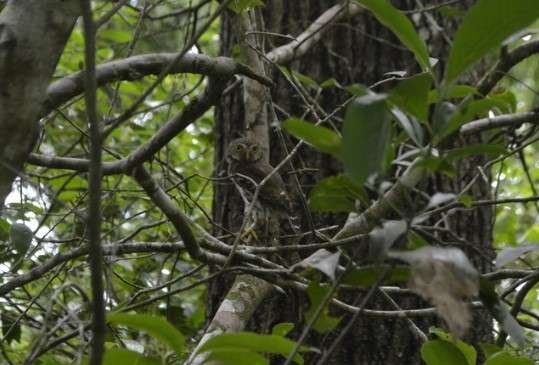
The Tamaulipas pygmy owl is a recently recognized species, and its relationship to the other pygmy owls is yet to be determined. They are seen in subtropical, humid regions of the northeastern parts of Mexico.
Their song comprises of 1-2 long, slow series of high pitches and hoots with long pauses in between. These owls are partly diurnal.
The adult owls are about 5.1 inches long and have a long tail of about 5.1 cm long. They have Brownish faces with white eyebrows. The crown is a rich Olive Brown.
There is fine white spotting at the front and at the sides of the crown. The females have a more Reddish Brown appearance, while the males have a more Olive Brown appearance.
- Scientific name: Glaucidium sanchezi
- Size: 5.1 inches
- Location: North-eastern Mexico
- Diet: Insects, small vertebrates, lizards
1) ELF OWL

Elf owls are the smallest owls on the planet. They are about 4.9 inches long and are about the size of a golf ball. Their wingspan is only 9 inches long. They have excellent vision and hearing, which helps them catch their prey.
Elf Owls are mostly found in desert habitats, where the Saguaro cacti are plenty. They recycle old woodpecker nets in these cacti as their homes.
Like the Flammulated owl, the Elf owl, too, is migratory. They migrate to Mexico during the winter and are very smart when it comes to tackling their predators.
In general, they are non-aggressive, but nesting elf owls gather up their neighbors and put up a fight against the predators and sometimes play dead until the danger has passed.
The elf owl is grayish-brown in color. They have rounded head that lacks feathers. It has Pale yellow eyes with thin White eyebrows. They lack ear tufts and have short tails. They have Buff-colored breasts with streaking.
- Scientific name: Micrathene whitneyi
- Size: 4.9 inches
- Location: North-eastern Mexico
- Diet: Insects, lizards, small vertebrates
Owls are remarkable creatures with incredible features distinct from normality. They are loved by millions of people around the world for their uniqueness and variety. Here we conclude our article on “Top 13 smallest owls in the world (2023)”. We will be back with many more such articles. Till then, stay tuned.
Also Read:

Nila is passionate about wildlife and is pursuing zoology. She is a curious individual who questions the mysteries of nature and is determined to unravel them. While she is an ardent student of photography, she cherishes passing her time playing the violin
